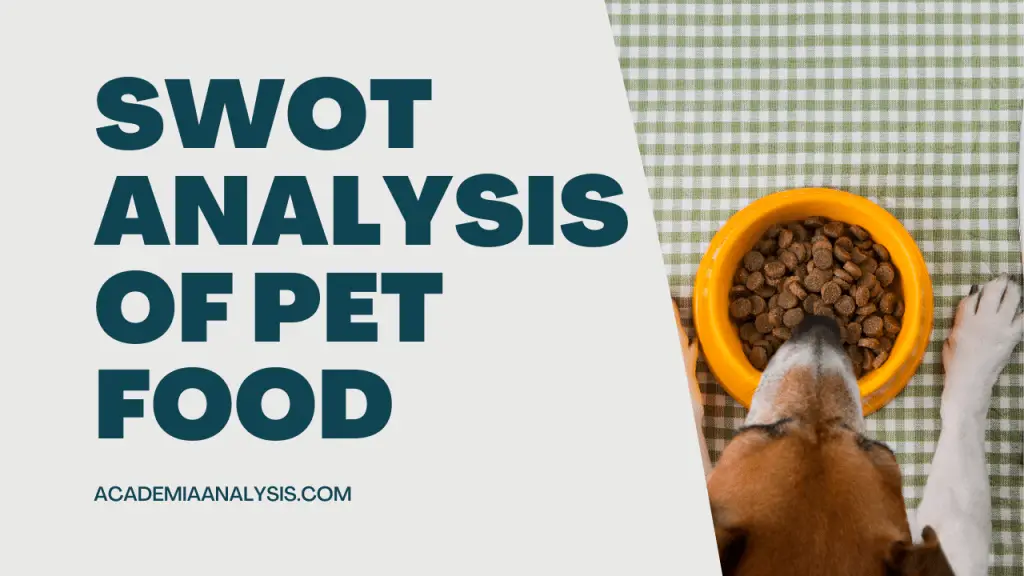The pet food industry is a thriving sector driven by the increasing number of pet owners worldwide who prioritize the health and well-being of their beloved companions. As a result, pet food companies face a unique set of opportunities and challenges in meeting the diverse dietary needs and preferences of pets. In order to navigate this dynamic landscape, it is crucial for pet food businesses to conduct a comprehensive SWOT analysis.
This analysis allows them to identify their strengths, weaknesses, opportunities, and threats, enabling informed decision-making and strategic planning. In this article, we will delve into a detailed SWOT analysis of the pet food industry, exploring the various factors that shape its present and future prospects. By understanding the industry’s internal strengths and weaknesses, as well as the external opportunities and threats it faces, pet food companies can position themselves for success in this competitive market.
Strengths:
- High demand: Pet food is in high demand due to the increasing number of pet owners globally. People consider their pets as family members and are willing to invest in high-quality food products for their well-being.
- Product variety: The pet food industry offers a wide range of products catering to different types of pets, breeds, ages, and specific dietary needs. This variety allows companies to target specific customer segments and meet their diverse requirements.
- Brand loyalty: Many pet owners develop a strong sense of brand loyalty when they find a pet food brand that suits their pet’s needs. This loyalty can lead to repeat purchases and positive word-of-mouth recommendations, contributing to the long-term success of pet food companies.
- Innovation and research: The pet food industry invests heavily in research and development to improve product formulations, enhance nutritional value, and create innovative packaging solutions. This focus on innovation helps companies stay ahead of the competition and meet evolving customer demands.
Weaknesses:
- Price sensitivity: While pet owners value high-quality food for their pets, price sensitivity remains a challenge. Some consumers may be reluctant to pay higher prices for premium pet food brands, especially in a competitive market where cheaper alternatives are available.
- Product recalls: Instances of product recalls due to contamination or quality issues can damage a pet food brand’s reputation and erode consumer trust. Companies must ensure strict quality control measures to avoid such incidents and maintain the trust of their customers.
- Limited shelf life: Pet food products typically have a limited shelf life compared to other food products. This can lead to waste and increased costs for manufacturers, distributors, and retailers if products are not sold within the specified timeframe.
- Dependence on ingredient sourcing: The pet food industry relies heavily on sourcing high-quality ingredients, such as meat and grains, to ensure the nutritional value of their products. Any disruptions or fluctuations in ingredient availability or pricing can impact production and supply chain operations.
Opportunities:
- Growing pet ownership: The number of pet owners worldwide is continually increasing, presenting a significant opportunity for the pet food industry. As more people adopt pets and consider them part of their families, the demand for pet food is expected to rise.
- Health and wellness trends: Consumers are increasingly conscious about the health and well-being of their pets. This has led to a growing demand for natural and organic pet food options, as well as products that cater to specific dietary needs, such as grain-free or hypoallergenic formulas.
- E-commerce and direct-to-consumer: The rise of e-commerce platforms and direct-to-consumer models offers pet food companies new avenues to reach customers. Online sales allow for wider distribution, improved accessibility, and the opportunity to gather valuable customer data for targeted marketing and product development.
- International expansion: The pet food industry has the potential for international expansion, especially in emerging markets where pet ownership and disposable incomes are on the rise. Entering new markets can help companies diversify their customer base and increase sales.
Threats:
- Competitive landscape: The pet food industry is highly competitive, with numerous established brands and new entrants vying for market share. Intense competition can lead to price wars, reduced profit margins, and the need for constant innovation to differentiate products.
- Regulatory compliance: Pet food manufacturers must comply with strict regulations and safety standards imposed by government bodies. Failure to meet these standards can result in legal consequences, product recalls, and damage to brand reputation.
- Changing consumer preferences: Consumer preferences and trends in pet food can change rapidly, driven by factors such as shifting dietary recommendations, emerging research, or evolving societal attitudes. Companies must stay abreast of these changes and adapt their product offerings accordingly.
- Economic factors: Economic downturns and fluctuations in disposable incomes can impact consumer spending on pet food. During challenging economic times, consumers may opt for more affordable pet food options or reduce their overall expenditure on pet-related products, posing a threat to the sales and profitability of pet food companies.
- Counterfeit products: The pet food industry is not immune to the risk of counterfeit products. Counterfeit pet food can harm pets’ health and undermine the reputation of legitimate brands. Companies need to implement robust quality control measures and educate consumers about the importance of purchasing from authorized retailers.
- Changing regulations: Regulatory requirements for pet food can change over time, including labeling, ingredient standards, and safety regulations. Keeping up with these changes and ensuring compliance can be challenging and may require significant investments in research, development, and production processes.
- Negative publicity: Negative publicity, such as product recalls, ingredient controversies, or animal welfare concerns, can significantly impact consumer perception and trust in a pet food brand. Companies must proactively address any negative issues, communicate transparently, and take necessary steps to rebuild trust and maintain a positive brand image.
Conclusion
Pet food industry has several strengths, including high demand, product variety, brand loyalty, and a focus on innovation. To mitigate threats like competition, regulatory compliance, changing consumer preferences, economic factors, counterfeit products, changing regulations, and negative publicity, pet food companies must remain vigilant, adaptable, and customer-centric in their strategies and operations.






